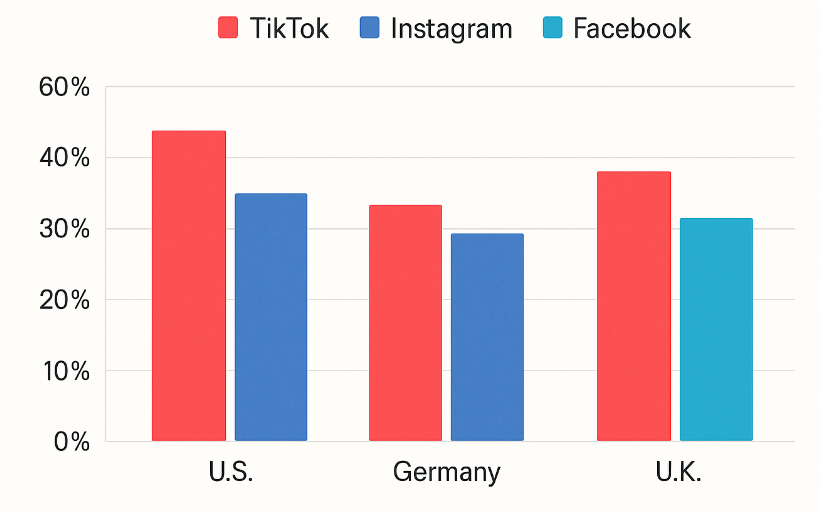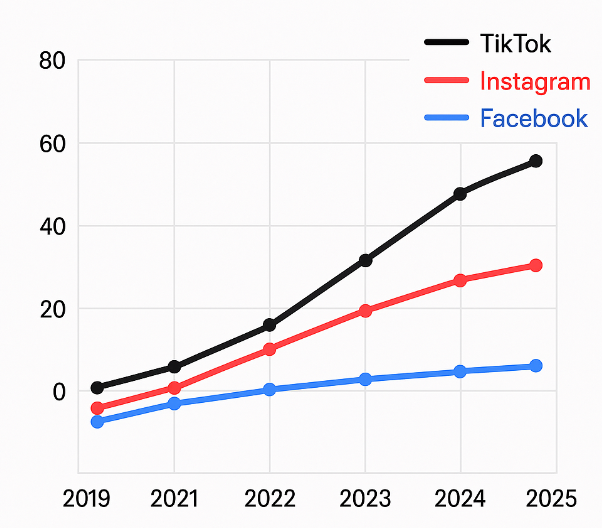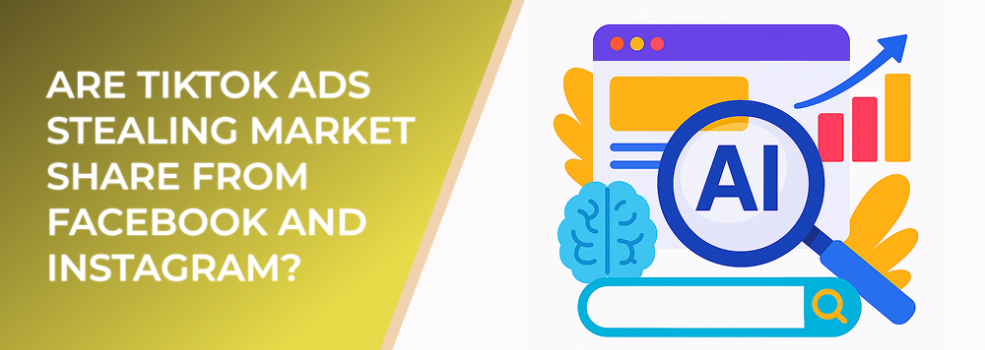TikTok has evolved from a viral entertainment platform into one of the most powerful advertising ecosystems in the world. According to Insider Intelligence, TikTok’s ad revenue grew by over 35% in 2024, surpassing $17 billion globally. The app now commands an estimated 8% share of global social media ad spending, up from just 2% three years ago.
In contrast, Meta’s combined ad platforms — Facebook and Instagram — still hold the largest share, but growth has slowed. While Meta’s ad revenue reached $135 billion in 2024, much of it came from incremental increases in existing advertisers rather than new ones.

TikTok’s growing share of social media ad revenue compared to Instagram and Facebook in key markets in 2023
TikTok’s unique short-form video format and its algorithm-driven discovery system have become a magnet for brands targeting younger demographics. For Gen Z users, TikTok is not just entertainment — it’s a search engine, a discovery platform, and a shopping channel.
Why Advertisers Are Shifting Budgets to TikTok
Marketers are increasingly experimenting with TikTok Ads for three key reasons:
1. Engagement and Attention Span
TikTok boasts the highest average engagement rate among major social platforms. Studies show that users spend an average of 54 minutes per day on TikTok, compared to 33 minutes on Instagram and 31 minutes on Facebook. The platform’s full-screen immersive format ensures higher ad visibility.
2. Cost Efficiency
While CPMs (cost per 1,000 impressions) on TikTok are rising, they’re still often 20–30% lower than those on Facebook or Instagram for similar demographics. This gives smaller brands more room to compete in performance-driven campaigns.
3. Authentic Creator Partnerships
TikTok’s influencer ecosystem makes ad creation easier and more organic. Brands can collaborate with micro-creators to produce UGC-style ads that feel native to the platform. These videos often outperform traditional polished creatives on Meta platforms.
Why Facebook and Instagram Still Dominate
Despite TikTok’s momentum, Meta still leads in terms of ad performance for certain objectives. Facebook and Instagram offer unmatched reach, audience targeting precision, and retargeting capabilities. Their integration with e-commerce tools, especially through Meta Pixel and Advantage+ Shopping Campaigns, provides an edge in conversion-driven advertising.

Average daily minutes spent per adult user: TikTok vs Instagram vs Facebook (forecast through 2025)
According to Statista, Meta platforms still account for over 45% of global social ad spend, while TikTok remains under 10%. The difference lies in maturity — Meta’s ad infrastructure is battle-tested, while TikTok is still refining its attribution, reporting, and targeting algorithms.
Additionally, Meta’s ability to serve both short-term conversion ads and long-term brand-building campaigns makes it indispensable for full-funnel marketing strategies.
The Emerging Multi-Platform Strategy
Smart advertisers are no longer choosing between platforms — they’re combining them. A 2024 survey by HubSpot found that 62% of brands now run cross-platform video campaigns on TikTok and Instagram simultaneously, using each for different stages of the funnel.
For example:
-
TikTok for awareness and engagement through creative storytelling.
-
Instagram Reels for credibility and product showcases.
-
Facebook Ads for conversions and retargeting.
With tools like LeadEnforce, advertisers can refine their targeting by analyzing audience overlap between platforms, helping allocate budgets to where they’ll perform best.
What This Means for Marketers
The battle between TikTok and Meta isn’t about one platform replacing the other. Instead, it’s about advertisers adapting to a multi-channel world. TikTok is capturing attention, but Facebook and Instagram remain the backbone of performance marketing.
For e-commerce brands, the winning formula often lies in testing TikTok creatives, retargeting through Meta Ads, and analyzing audience performance with data-driven tools.
As TikTok continues to innovate with AI-driven ad targeting and in-app shopping integrations, it’s likely to keep gaining ground — but Meta’s massive user base and proven ROI ensure it will remain a cornerstone of digital advertising.
Final Thoughts
TikTok is not overtaking Facebook and Instagram yet — but it’s forcing them to evolve. Marketers who diversify their ad strategies across both ecosystems will be best positioned to thrive in the changing digital landscape.

